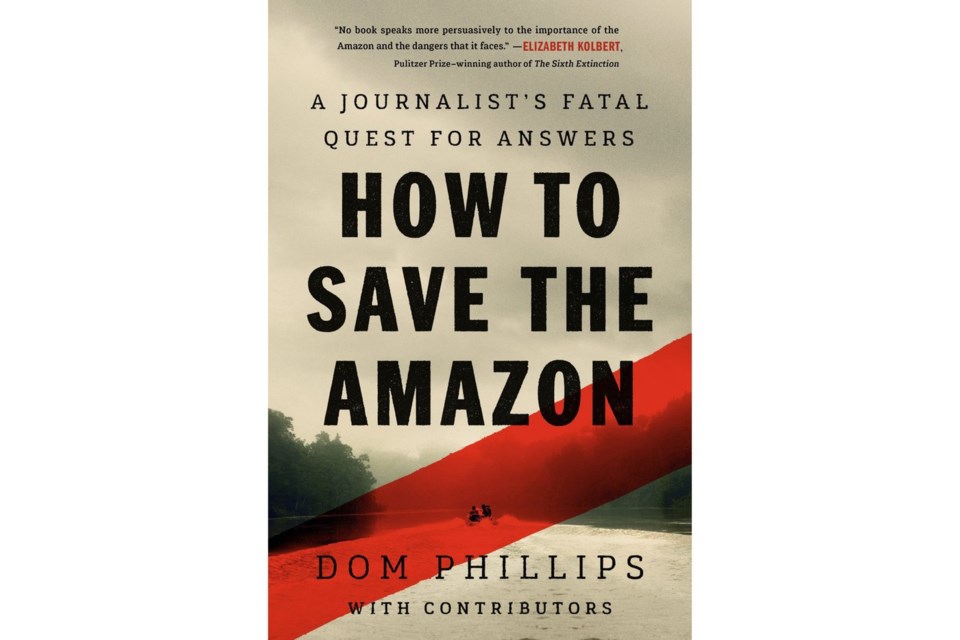BRASILIA, Brazil (AP) — After British journalist Dom Phillips was shot and killed while researching an ambitious book on how to protect the world’s largest rainforest, friends vowed to finish the project. Three years later, their task is complete.
“How to Save the Amazon,” published Tuesday in Brazil and the United Kingdom ahead of its U.S. release, was pieced together by fellow journalists who immersed themselves in Phillips’ notes, outlines and the handful of chapters he’d already written. The resulting book, scheduled to be published in the U.S. on June 10, pairs Phillips’ own writing with others’ contributions in a powerful examination of the cause for which he gave his life.
In addition to the core group who led the work on finishing the book, other colleagues and friends helped to edit chapters, including The Associated Press journalists Fabiano Maisonnave and David Biller.
Phillips, who had been a regular contributor to The Guardian newspaper, was taking one of the final reporting trips planned for his book when he was gunned down by fishermen on June 5, 2022, in western Amazon’s Javari Valley. Also killed was Bruno Pereira, a Brazilian expert on Indigenous tribes who had made enemies in the region for defending the local communities from intruding fishermen, poachers and illegal gold miners. Their deaths made headlines around the world. Nine people have been indicted in the killings.
“It was just a horrifying, really sad moment. Everybody was trying to think: How can you deal with something like this? And the book was there,” said Jonathan Watts, an Amazon-based environmental writer for The Guardian who coauthored the foreword and one of the chapters.
With the blessing of Phillips’ widow, Alessandra Sampaio, a group of five friends agreed to carry the project forward. The group led by Watts also included Andrew Fishman, the Rio-based president of The Intercept Brasil; Phillips’ agent, Rebecca Carter; David Davies, a colleague from his days in London as a music journalist; and Tom Hennigan, Latin America correspondent for The Irish Times.
“It was a way to not just feel awful about what had happened, but to get on with something. Especially because so many of Dom’s friends are journalists,” Watts said. “And what you fall back on is what you know best, which is journalism.”
Unfinished work researching rainforest solutions
By the time of his death, Phillips had traveled extensively across the Amazon and had completed an introduction and nearly four of the 10 planned chapters. He also left behind an outline of the remaining chapters, with different degrees of detail, and many pages of handwritten notes, some of them barely legible.
“I think it’s fair to say even Dom didn’t yet know what he would do exactly in those chapters,” Watts said.
Phillips was searching for hope. He promised his editors a character-driven travel book in which readers would get to know a wide-ranging cast of people living in the area, “all of whom know and understand the Amazon intimately and have innovative solutions for the millions of people who live there.”
The group led by Watts selected writers for the remaining chapters, with subjects ranging from a bioeconomy initiative in Brazil’s Acre state to global funding for rainforest preservation. Indigenous leader Beto Marubo of the Javari Valley was recruited to co-write an afterword. The team also launched a successful crowdfunding campaign to pay for more reporting trips.
Among the group’s challenges was ensuring that the book reflected a political shift in Brazil’s approach to the Amazon in the years since Phillips’ death. Most of Phillips’ research was done during the term of right-wing President Jair Bolsonaro, as Brazil’s Amazon deforestation reached a 15-year high in 2021. The pace of destruction slowed after Bolsonaro’s 2022 defeat by leftist leader Luiz Inácio Lula da Silva.
Fragments of hope, grim statistics
Throughout the finished book’s more than 300 pages, fragments of hope mix with grim realities. In Chapter 2, “Cattle Chaos,” Phillips notes that 16% of Brazil’s Amazon has already been converted to pasture. Even a farmer who has become a model for successfully increasing productivity without clearing most of his land is criticized for his widespread use of fertilizers.
In his chapter on bioeconomy, journalist Jon Lee Anderson visits a reforestation initiative where Benki Piyãko, an Ashaninka leader, promotes environmental restoration coupled with ayahuasca treatment and a fish farm. But the veteran reporter doesn’t see how it can be scalable and reproducible given man-made threats and climate change.
Later in the chapter, he quotes Marek Hanusch, a German economist for the World Bank, as saying: “At the end of the day, deforestation is a macroeconomic choice, and so long as Brazil’s growth model is based on agriculture, you’re going to see expansion into the Amazon.”
In the foreword, the group of five organizers state that “Like Dom, none of us was under any illusion that our writing would save the Amazon, but we could certainly follow his lead in asking the people who might know.”
But in this book stained by blood and dim hope, there is another message, according to Watts: “The most important thing is that this is all about solidarity with our friend and with journalism in general.”
___
The Associated Press’ climate and environmental coverage receives financial support from multiple private foundations. AP is solely responsible for all content. Find AP’s standards for working with philanthropies, a list of supporters and funded coverage areas at AP.org.
Fabiano Maisonnave, The Associated Press



